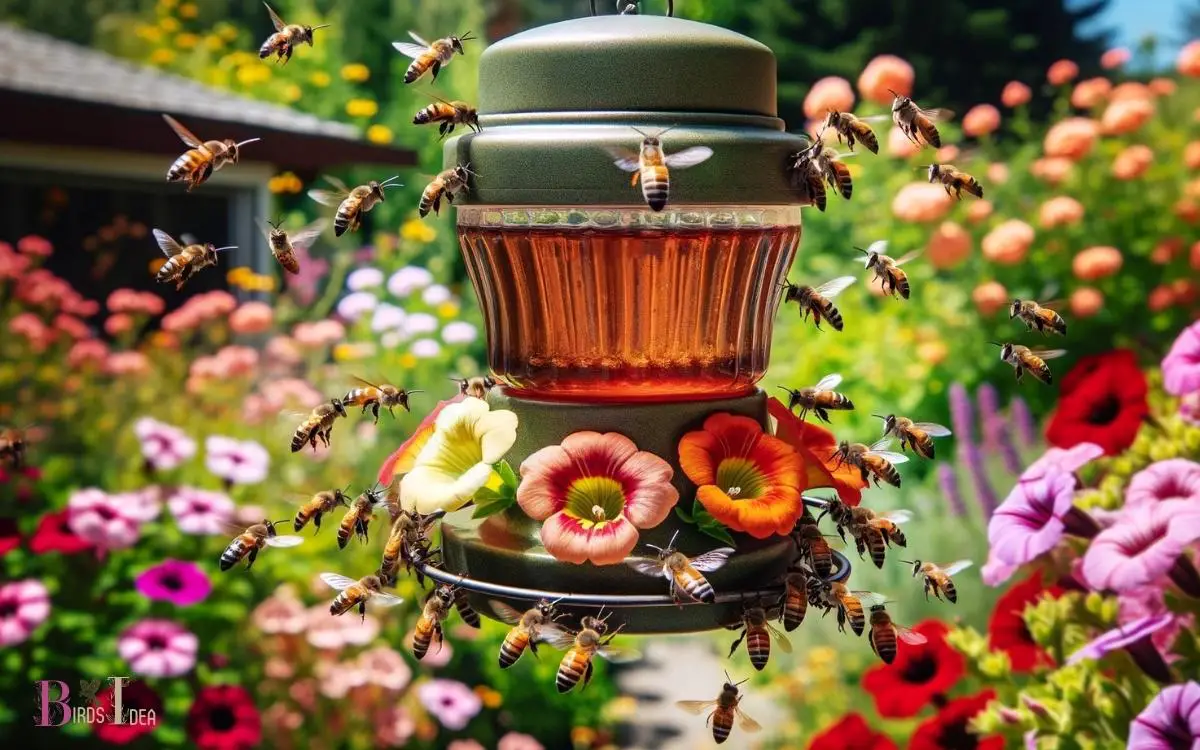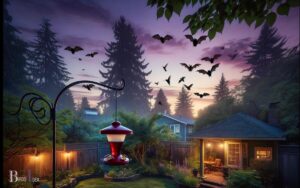Do Hummingbird Feeders Attract Bees? Yes!
Yes, hummingbird feeders can attract bees, especially if the feeders are not designed to be bee-resistant or if the sugar solution is too concentrated.
Hummingbird feeders attract bees for a couple of reasons.
To reduce bee attraction to hummingbird feeders, select bee-proof designs, maintain a proper sugar-water ratio, and position the feeders in shaded areas away from direct sunlight.

Key Takeaway
Understanding Bee Behavior Around Feeders
Bees are often attracted to hummingbird feeders due to the sweet nectar they contain. When bees discover a food source, they communicate its location to other bees, leading to an increase in bee activity around the feeder.
Additionally, the color yellow, commonly found on hummingbird feeders, attracts bees as they are naturally drawn to this color.
This can lead to a situation where bees dominate the feeder, making it less accessible to hummingbirds.
To address this issue, it is recommended to choose feeders with bee guards or those specifically designed to deter bees.
Placing the feeder in a partially shaded area can also help, as bees are less likely to forage in shaded locations.
Understanding bee behavior and employing strategies to mitigate their attraction to hummingbird feeders can ensure a more welcoming environment for hummingbirds.
Factors That Attract Bees to Hummingbird Feeders
Attracted by the sweet nectar and the color yellow, bees are drawn to hummingbird feeders, leading to increased bee activity around the feeders.
There are several factors that contribute to the attraction of bees to hummingbird feeders:
- Sweet Nectar: Bees are naturally attracted to the sweet taste of nectar, making hummingbird feeders an appealing food source for them.
- Color: The color yellow, commonly found on hummingbird feeders, is attractive to bees as it resembles the color of flowers that they typically feed on.
- Scent: Some hummingbird feeders may have a scent or aroma that is appealing to bees, further attracting them to the feeders.
- Accessibility: If the feeder design allows easy access to the nectar, bees will be more likely to visit and feed from the feeder.
Understanding these factors can help in managing bee activity around hummingbird feeders.
Tips for Minimizing Bee Activity at Feeders
If you want to minimize bee attraction to hummingbird feeders, here are some tips you can try:
- Choose the Right Feeder Design: Opt for feeders with bee-resistant features, such as built-in bee guards or specialized designs that make it difficult for bees to access the nectar.
- Use Red-Colored Feeders: Bees are less attracted to red, so using a red-colored hummingbird feeder may help deter them. Hummingbirds, on the other hand, are attracted to the color red.
- Adjust Perch Design: Choose feeders with perches that are suitable for hummingbirds but less accessible for bees. Hummingbirds prefer horizontal perches, while bees find it more challenging to navigate.
- Place Feeders in Shaded Areas: Bees are more active in direct sunlight. Placing your feeder in a shaded area can make it less attractive to bees while still being accessible to hummingbirds.
- Opt for Nectar Guards: Some feeders come with nectar guards or moats that can prevent bees from reaching the nectar. These are reservoirs that create a barrier between the nectar and potential bee intruders.
- Use Bee Repellent or Barrier Products: There are commercial bee repellent products designed specifically for hummingbird feeders. Applying these products according to the instructions can help keep bees away.
- Regular Cleaning: Clean the feeder regularly to remove any spilled nectar or sticky residue. Bees are attracted to the smell of sugar, so keeping the feeder clean can discourage them.
- Change the Nectar Ratio: Adjust the nectar concentration to a ratio of 4 parts water to 1 part sugar. This concentration is preferred by hummingbirds but less appealing to bees.
- Hang Feeders at the Right Height: Position the feeder at a height that is convenient for hummingbirds but more challenging for bees to access. Hummingbirds are better equipped to reach higher locations.
- Use Bee Traps: Consider placing bee traps or decoy feeders filled with a diluted sugar solution away from the hummingbird feeder to attract bees away from the main feeding station.
Remember to observe and adjust these strategies based on your specific situation, as different environments and bee species may respond differently to these deterrents.
Creating a Bee-Friendly Environment for Hummingbirds
Creating a bee-friendly environment for hummingbirds involves strategically planting nectar-rich flowers in the vicinity of feeders.
This not only provides a natural food source for the hummingbirds but also helps attract and divert bees away from the feeders.
Some nectar-rich flowers that are particularly attractive to hummingbirds and less appealing to bees include bee balm, salvia, and penstemon.
It’s important to choose a variety of flowers that bloom at different times throughout the year to ensure a continuous nectar supply.
Additionally, avoiding pesticide use in the garden will help protect the bees and other pollinators, creating a more welcoming environment for the hummingbirds.
By creating a diverse and pesticide-free garden with nectar-rich flowers, individuals can effectively support the needs of both hummingbirds and bees.
Conclusion
While hummingbird feeders are designed to attract hummingbirds, they often unintentionally attract bees as well.
Despite efforts to minimize bee activity at feeders, it seems that bees are always finding a way to join the party.
So, if you thought setting up a feeder would bring peaceful, bee-free moments with hummingbirds, think again. It looks like the bees are here to stay, whether we like it or not.






